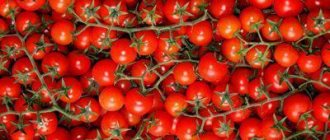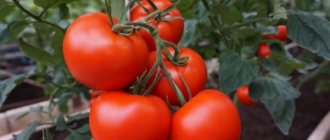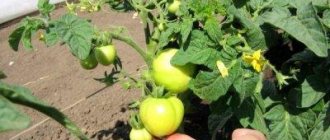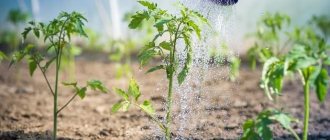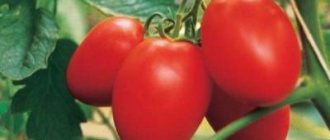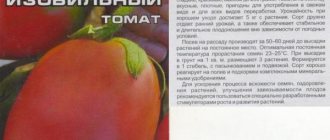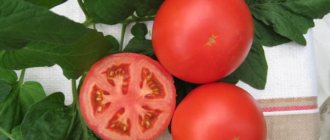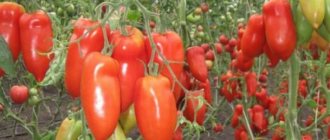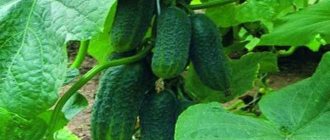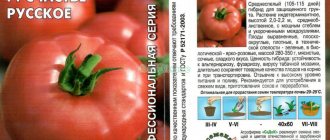Diva F1 is an ideal hybrid for the short northern summer. It is capable of producing a rich harvest within a short time after sowing the seeds. This is especially valuable when the warm period is of short duration.
| Height | Landing location | Ripening time | Fruit color | Fruit size | Origin | Fruit shape |
| Medium height | Open ground | Ultra early | Reds | Average | Hybrid | With spout |
Description and characteristics of the variety
Hybrid Primadonna F1 was included in the register in 2007. The author of the cultivar is Yuri Ivanovich Panchev, an employee of the research center for selection of seed production and agricultural technology of Transnistria.
Panchev is a famous breeder. He developed and patented 25 varieties of tomatoes, including the mega-popular Sanka and Lyana.
In addition to the original designer seeds, sold in branded bags marked NICSSA, you can find Primadonna on sale, sold under the following trademarks:
- tomato Primadonna F1 Biotechnika;
- tomato Primadonna Sedek;
- tomato Diva Aelita;
- tomato Primadonna Siberian Garden.
Primadonna is an early determinate hybrid for film greenhouses and open ground with red fruits of a specific shape. The variety's tomatoes are round, with a smooth surface, almost without ribs. The nose protrudes from below the fetus.
Tomatoes ripen 90-95 days after germination.
Fruits weighing about 180 g, for salad purposes, with four to six nests, taste and commercial quality are high.
The height of the bush is up to 130 cm. Few leaves are formed. The tomatoes are well lit by the sun and ventilated. Due to the small number of leaf plates, cleaning is carried out without much difficulty.
Diseases and pests
This hybrid has high immunity, so the Primadonna tomato is not susceptible to most of the main diseases characteristic of other tomato varieties, in particular:
- verticillium;
- late blight;
- Alternaria;
- cladosporiosis;
- mosaic of tomatoes.
It is also not damaged by pests.
However, for disinfection and preventive purposes, seed material should be soaked for half an hour in a light solution of potassium permanganate before sowing. But potassium permanganate is often replaced with the following drugs:
- warm 3% hydrogen peroxide solution;
- 1% acetic acid solution;
- boric acid;
- copper sulfate.
INTERESTING TO KNOW!
Reasons why leaves on tomatoes dry and turn yellow
To prevent attacks by “harmful” bugs, Primadonna tomato bushes are treated with an insecticide solution several times a season.
Advice!
The following measure is effective against nematodes: calendula and marigolds are planted between rows. The roots of these flowers produce a special substance - theophene, which is capable of killing “harmful” bugs.
Advantages and disadvantages
Pros:
- resistance to late blight;
- early ripeness;
- does not require capital greenhouses;
- excellent taste, which is ensured by the optimal combination of organic acids and sugar;
- good tying in cold rainy weather;
- genetic resistance to a complex of diseases of open ground tomatoes;
- transportable;
- productive;
- high adaptive abilities.
Minuses:
- tall bushes - requires tying;
- you have to make stepsons, however, few side branches are formed;
All the pros and cons: is it worth planting?
The Primadonna variety has a lot of advantages:
- unpretentious;
- resistant to fungal diseases;
- ripens quickly;
- not subject to rotting processes;
- has high productivity;
- can be stored for a long time;
- successfully transported.
See also Features of cultivation, characteristics and descriptions of Explosion tomatoes
If we talk about shortcomings, it is worth highlighting the height of culture. Not every greenhouse has the opportunity to grow tomatoes that grow 1.2 m upward. Also, the seeds of the species are not collected for sowing the next season due to the fact that they will not inherit the properties of the mother crop.
Features of cultivation and storage
Early maturing hybrids of limited growth stop developing after the formation of 4-5 clusters. Unlike super-determinate cultivars, which do not need to be pinched at all (Lyana, Novinka Pridnestrovya), the plant has to fight the stalks, otherwise the bush will be overloaded with berries and ripening will be delayed. At the same time, the variety loses its main advantage - early production of ripe fruits.
The first flower cluster is tied after 5-7 leaves, the next ones every two leaves. The bushes have to be propped up with pegs so they don’t fall.
Tomatoes are grown only through seedlings. Planting of plants in open ground or a greenhouse is carried out when the soil warms up to at least 15 degrees and the danger of cold snaps disappears to temperatures below +10 degrees. Seedlings are placed in the garden according to a 50 by 40 cm pattern.
For good growth, plants will need:
- timely watering,
- regular feeding,
- loosening the soil
- weeding.
Despite their salad purpose, the fruits are well stored, as they have dense pulp and durable skin. They not only last a long time, but are also easily transported, which makes this hybrid suitable for commercial production.
Tomatoes Diva on video
If you grew Primadonna tomatoes, please write what the yield and taste of the fruit were in your climatic conditions. How do you rate the disease resistance of this tomato? Briefly describe the advantages and disadvantages of this tomato in your opinion. If possible, attach a photo of the entire bush or individual fruits you grew to your comment. Thank you!
More than 1,600 varieties of tomatoes with photos, descriptions and reviews from gardeners in our Tomato Catalog. Enjoy watching.
Your reviews of the Primadonna tomato and additions to the description will help many gardeners evaluate this hybrid more objectively and decide whether it is worth planting or not.
Sowing seeds of Diva F1
The seeds are placed in increments of 2 cm, after which the crops are covered with soil and, using a fine spray (so that the stream does not move the seeds to the surface), the crops are thoroughly moistened.
The crops are then covered with film or glass to maintain a constant temperature and humidity necessary for seed germination.
Features of caring for the Primadonna tomato
The variety does not require special care. Maximum attention is paid to the crop during the growing season.
See also Hali Gali tomatoes: yield and reviews of the variety
Watering and fertilizing
In the first week, systematic watering is carried out at the root. It is necessary to take only warm liquid. Further watering is carried out as needed.
Fertilizing is carried out 10 days after planting the tomatoes, and then once every 2 weeks until the plant begins to bear fruit. Phosphorus-potassium fertilizers are often applied.
Bush formation
Culture must be formed. This is done to improve productivity.
Preventative treatments
In order to prevent nematodes, it is recommended to plant calendula or marigolds near bushes with crops. These plants secrete a substance that kills parasites. A couple of weeks before harvest, preventive treatment of the crop against parasites is carried out.
Loosening and mulching the soil
Mulch the soil to ensure that the plant is provided with sufficient moisture. Also, such an event will speed up the maturation process. It is better to use organic matter - hay with humus, pine needles, sawdust.
Loosen and weed the crop as needed.
Growing seedlings
Tomato seedlings begin to be grown two months before they are planted in open ground. In most regions, seeds are sown in March.
Before sowing planting material, you should familiarize yourself with the lunar calendar. It is believed that tomatoes planted on the correct lunar day germinate faster.
Seed preparation
Before planting the seeds, they are sorted out. Dense light seeds without stains or damage are suitable for use.
It is important to check the expiration dates on the packaging
Disinfecting seeds will prevent diseases from infecting plants. Usually, for these purposes, planting material is soaked for half an hour in potassium permanganate, diluted in a ratio of 1 g per 10 ml. After soaking, the seeds are washed under running water.
To speed up seed germination, they are soaked in growth stimulants or other methods are used.
The list contains the most common of them:
- Purchased drugs. Most often, Epin or Fitosporin are used to stimulate growth. Seeds are processed as indicated in the instructions on the package.
- Folk remedies. The most effective are: aloe juice, diluted in a 1:1 ratio with water, a soda solution, for the preparation of which you need to take 1 teaspoon of soda per glass of liquid, honey solution, prepared from 1 teaspoon of honey and a glass of water. Planting material is soaked in such stimulants for 12 hours.
- Plain water. To use this method, pieces of gauze are moistened in clean water. The seeds are wrapped in them. The fabric with the seeds is placed in a saucer, which is covered with film and placed in a warm place. The seeds are left in this form until germination. This takes 2-3 days.
Selection of soil and containers
To grow tomatoes you will need the right containers. This determines how comfortable the plants will feel.
For sowing seeds, choose large but shallow containers. It is not necessary to use special trays and boxes.
Pots are often made from scrap materials:
- instant noodle trays;
- plastic containers for herring and seafood;
- cake packaging;
- plastic disposable tableware;
- cut six-liter bottles.
For picking plants, use containers with a volume of 300 ml. Stores sell special plastic and peat pots. Often, disposable cups and cut-off bottles are used for planting seedlings.
All containers are disinfected before use. To do this, they are soaked for half an hour in a strong solution of potassium permanganate.
Soil for tomatoes is no less important than containers. You can buy it at a gardening store or make it yourself. In any case, soil mixtures are treated with high temperatures or a solution of potassium permanganate.
To prepare the soil for tomatoes, mix chernozem with humus in different proportions. Ash and “Superphosphate” are added to the mixture. To make the soil lighter, add one part of sand, sawdust, peat or crushed coconut fiber.
Farmer reviews
- Oh, very tasty tomatoes! I’ve been planting them at the dacha for years now - everyone is happy, I always get some juice and we’ll gorge ourselves on salads over the summer! Children enjoy eating straight from the bush! Sweet and juicy Divas.
- I've been planting them for probably three years. I can say that there are more advantages than disadvantages: firstly, I have never been sick, even in the cold summer I was not attacked by late blight. Secondly, there are a lot of tomatoes, enough to eat, freeze, and make salads for the winter. Thirdly, the bushes are tall, slender, and easy to collect. I plant them both in the greenhouse and in the open air, they grow equally well. True, you still have to plant a small-fruited variety in order to spin it in a jar.
- The bushes are healthy, for my taste, the tomatoes are sour, too large to spin. It is inconvenient to care for; you constantly have to peel off the leaves and tie them up. There was a strong wind in the summer - half of the bushes were broken, even though I tied them tightly. Too much fuss, they take up a lot of space in the dacha. I like short, neat bushes more than such giants.
- I grow tomatoes like this and I don’t see anything special. In the greenhouse, yes, it’s convenient - they are tall, easier to collect. I get sick, like all the other varieties I plant. My husband likes it and says it’s delicious, so I plant a little bit. What’s bad is that you can’t collect seeds, because these are hybrids. For me, it’s better to collect your own seeds and not buy any artificial chemicals. But here it’s up to your taste. Some people will like these, others like our simple varieties.
Growing delicious tomatoes is not the most difficult task for an experienced summer resident. The most important thing is to choose a variety or hybrid that suits your tastes. Diva F1 is ideal for those who value their time and like to get everything they need from one plant. Namely, tomatoes that can be eaten fresh, from which delicious juices are obtained that can be sent as a treat for out-of-town relatives.
Video about Primadonna tomatoes:
